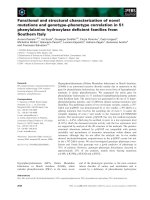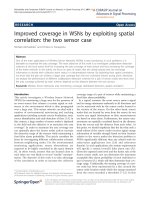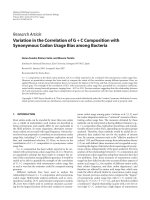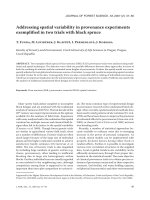Genotype–phenotype correlation in two Polish neonates with alveolar capillary dysplasia
Bạn đang xem bản rút gọn của tài liệu. Xem và tải ngay bản đầy đủ của tài liệu tại đây (1.82 MB, 7 trang )
Kozłowska et al. BMC Pediatrics
(2020) 20:320
/>
CASE REPORT
Open Access
Genotype–phenotype correlation in two
Polish neonates with alveolar capillary
dysplasia
Zuzanna Kozłowska1* , Zuzanna Owsiańska1, Joanna P. Wroblewska2, Apolonia Kałużna2, Andrzej Marszałek2,
Yogen Singh3, Bartłomiej Mroziński4, Qian Liu5, Justyna A. Karolak6, Paweł Stankiewicz5, Gail Deutsch7,
Marta Szymankiewicz-Bręborowicz1 and Tomasz Szczapa1
Abstract
Background: Alveolar capillary dysplasia (ACD) is a rare cause of severe pulmonary hypertension and respiratory
failure in neonates. The onset of ACD is usually preceded by a short asymptomatic period. The condition is
refractory to all available therapies as it irreversibly affects development of the capillary bed in the lungs. The
diagnosis of ACD is based on histopathological evaluation of lung biopsy or autopsy tissue or genetic testing of
FOXF1 on chromosome 16q24.1. Here, we describe the first two Polish patients with ACD confirmed by
histopathological and genetic examination.
Case presentation: The patients were term neonates with high Apgar scores in the first minutes of life. They both
were diagnosed prenatally with heart defects. Additionally, the first patient presented with omphalocele. The
neonate slightly deteriorated around 12th hour of life, but underwent surgical repair of omphalocele followed by
mechanical ventilation. Due to further deterioration, therapy included inhaled nitric oxide (iNO), inotropes and
surfactant administration. The second patient was treated with prostaglandin E1 since birth due to suspicion of
aortic coarctation (CoA). After ruling out CoA in the 3rd day of life, infusion of prostaglandin E1 was discountinued
and immediately patient’s condition worsened. Subsequent treatment included re-administration of prostaglandin
E1, iNO and mechanical ventilation. Both patients presented with transient improvement after application of iNO,
but died despite maximized therapy. They were histopathologically diagnosed post-mortem with ACD. Array
comparative genomic hybridization in patient one and patient two revealed copy-number variant (CNV) deletions,
respectively, ~ 1.45 Mb in size involving FOXF1 and an ~ 0.7 Mb in size involving FOXF1 enhancer and leaving FOXF1
intact.
Conclusions: Both patients presented with a distinct course of ACD, extra-pulmonary manifestations and response
to medications. Surgery and ceasing of prostaglandin E1 infusion should be considered as potential causes of this
variability. We further highlight the necessity of thorough genetic testing and histopathological examination and
propose immunostaining for CD31 and CD34 to facilitate the diagnostic process for better management of infants
with ACD.
Keywords: Alveolar capillary dysplasia, FOXF1 mutation, Respiratory failure, Neonate, Pulmonary hypertension
* Correspondence:
1
Department of Neonatology, Neonatal Biophysical Monitoring and
Cardiopulmonary Therapies Research Unit, Poznan University of Medical
Sciences, Poznan, Poland
Full list of author information is available at the end of the article
© The Author(s). 2020 Open Access This article is licensed under a Creative Commons Attribution 4.0 International License,
which permits use, sharing, adaptation, distribution and reproduction in any medium or format, as long as you give
appropriate credit to the original author(s) and the source, provide a link to the Creative Commons licence, and indicate if
changes were made. The images or other third party material in this article are included in the article's Creative Commons
licence, unless indicated otherwise in a credit line to the material. If material is not included in the article's Creative Commons
licence and your intended use is not permitted by statutory regulation or exceeds the permitted use, you will need to obtain
permission directly from the copyright holder. To view a copy of this licence, visit />The Creative Commons Public Domain Dedication waiver ( applies to the
data made available in this article, unless otherwise stated in a credit line to the data.
Kozłowska et al. BMC Pediatrics
(2020) 20:320
Background
Respiratory failure is a common problem in the Neonatal Intensive Care Unit (NICU) and the diagnosis is
often a challenge. Severe respiratory failure is usually observed in neonates with interstitial parenchymal lung
diseases and congenital cardiac defects.
Alveolar capillary dysplasia with misalignment of pulmonary veins (ACDMPV) (MIM# 265380), frequently
referred to as alveolar capillary dysplasia (ACD), is a rare
disorder, leading to early severe respiratory distress with
a persistent pulmonary hypertension (PPHN) and almost
universally to death. Most of the affected infants present
hypoxic respiratory failure within 48 h of life that is refractory to all medical therapies, including pulmonary
vasodilators [1].
In 80–90% of histopathologically-verified ACD cases,
loss-of-function of the FOXF1 gene (MIM# 601089) on
16q24.1 or its distant upstream lung-specific enhancer has
been described [1–4]. FOXF1 encodes a Forkhead box F1
transcription factor primarily expressed in mesodermderived tissues during lung organogenesis, involved in development of pulmonary alveoli and capillaries [5–7].
Here, we present two neonates hospitalized in the tertiary NICU due to severe respiratory failure and pulmonary hypertension. Both patients were diagnosed with
ACD due to different-sized heterozygous copy-number
variant (CNV) deletions within the FOXF1 gene locus on
16q24.1. They are the first patients with histopathologically- and genetically-confirmed ACD in Poland.
Case presentation
Case 1
A male neonate (birth weight: 2920 g) was born via caesarean section at 39+1 weeks of gestation in a non-tertiary
hospital. On prenatal examination polyhydramnios, omphalocele, hydronephrosis of the right kidney and ventricular septal defect (VSD) were suspected.
Amniocentesis showed 47, XY,+22 cells in the sample,
however, postnatal karyotype was normal (46,XY). The
Apgar scores were 9 at the 1st and 10 at the 5th minute of
life. The infant was transferred to the NICU in a stable
condition. In the 12th hour of life, oxygen saturation measured with pulse oximetry (SpO2) decreased below 90% passive oxygen therapy was applied with FiO2=0.6. Surgical repair of omphalocele was performed at 17th hour of
life. Due to respiratory deterioration after the surgery, the
newborn received conventional mechanical ventilation
with FiO2=0.4. Persistent pulmonary hypertension, atrial
septal defect (ASD) and VSD were diagnosed on echocardiography examination. PPHN was treated with iNO but
only with transient improvement. On the second day of
life, the patient required ventilation with FiO2=1, surfactant administration and inotropes. On the third day, SpO2
remained persistently below 80%. Consequently, the infant
Page 2 of 7
was switched to high frequency ventilation but without
any improvement. Despite continuation of this therapy
during the next few days, SpO2 decreased further below
60%. Physical examination showed hepatosplenomegaly.
Additional testing revealed coagulopathy, lack of peristalsis, congestion in the lungs, and metabolic acidosis. The
patient died on the 13th day of life after a cardiac arrest
and ineffective cardiopulmonary resuscitation.
Case 2
A male neonate (birth weight: 2400 g) was born via vaginal delivery at 39 weeks of gestation. On the prenatal
examination fetal growth restriction and coarctation of
the aorta (CoA) were suspected. The infant was born in
a non-tertiary hospital in good condition; the Apgar
scores were 8 at the 1st and 10 at the 5th minute. The
newborn presented with peripheral cyanosis in the first
hours of life and a difference between pre- and postductal saturation ranging about 10% was noted. Continuous infusion of prostaglandin E1 was applied due to
prenatal suspicion of CoA. Initial echocardiogram
showed ASD and VSD. On the second day of life, the infant was transferred to the NICU in Poznań. During the
echocardiography examination infusion of prostaglandin
was stopped and the infant suddenly deteriorated. CoA
was not confirmed. The echocardiography revealed
PPHN with a large ductus arteriosus (bidirectional shunt
with right to left predominance) and narrow pulmonary
veins. The patient was intubated, prostaglandin infusion
was re-administered and PPHN was treated with iNO,
resulting in immediate improvement. During the next
few days, deterioration of the general condition with increasing oxygen demand up to 100% oxygen was observed. On the 9th day of life, SpO2 was below 65%
despite maximized respiratory support. Physical examination displayed liver and spleen enlargement. Additional
testing showed hypotension, lack of peristalsis, congestion in the lungs and metabolic acidosis. On the 10th day
of life, cardiopulmonary resuscitation was not effective
and the patient died due to cardiac arrest.
Histopathological and genetic findings
Subjects
Lung tissue specimens were collected by post-mortem
biopsy in both patients. Informed consents for histopathological examination of the lung samples and genetic testing were obtained from the patients’ parents.
Lung tissue from a 2-week-old term infant was used as
an internal control.
Histopathological evaluation
Formalin-fixed paraffin-embedded (FFPE) lung tissue
samples were stained with hematoxylin and eosin (H&E).
In addition, immunohistochemical (IHC) staining was
Kozłowska et al. BMC Pediatrics
(2020) 20:320
performed on 4.5 μm FFPE tissue sections, using the En
Vision™ FLEX GV800 (Dako) IHC Kit with specific monoclonal antibodies for CD34 and CD31. The IHC reaction
was carried out using the OMNIS (Dako) or the BenchMark Ultra (Ventana Roche). Results were verified with an
Olympus microscope. All stained tissue slides were archived by the VisionTek® Digital Microscope (Sakura).
DNA extraction
Genomic DNA isolation was performed using the MagCoreNucleid Acid Extractor (RBC Bioscience) with the
sets of reagents dedicated to FFPE samples. DNA was
quantified with the NanoDrop 2000 spectrophotometer
(ThermoFisher Scientific).
Sanger sequencing
PCR reactions were performed using C1000 Touch thermal cycler (BioRad), with set of primers covering the
whole coding region of FOXF1. Primers and PCR conditions are available on request. After amplification, PCR
products were purified in an enzymatic reaction, diluted
and sequenced using the forward and reverse primers
with the BigDye Terminator 3.1 kit (ThermoFisher Scientific) according to manufacturer’s instruction. Next,
products were purified by ethanol precipitation and analyzed with the 3500 Genetic Analyzer (Applied Biosystems)
and
the
CodonCodeAlligner
Software
(CodonCode Corporation).
Array comparative genomic hybridization (array CGH)
The array CGH analysis of patients was performed using
a customized 16q24.1-specific high-resolution 180 K
microarray (Agilent Technologies), as described [3].
Results
In both cases, histopathological examination of post
mortem lung biopsy samples revealed a significant decrease in the capillary network as well as abnormal shunt
vessels in the bronchovascular bundle and blood-air barrier underdevelopment, features characteristic for ACD.
Diffuse thickening of interalveolar septa, reduction of
density and malpositioning of pulmonary alveolar capillaries were also observed. Residual acute alveolar damage
was slightly more pronounced in Patient 1′ samples. Immunostaining for the endothelial markers CD34 and
CD31 highlights poor approximation of the alveolar capillaries to epithelial cells and marked congestion compared to control lung from the term infant resulting in
disruption of air-blood barrier (Fig. 1.)
Direct sequencing did not reveal any clinically relevant
single nucleotide variants or indels within the coding
portion of FOXF1 in these patients. Array CGH revealed
the heterozygous CNV deletions at 16q24.1 region in
both cases. In Patient 1, an ~ 1.45 Mb CNV deletion
Page 3 of 7
(chr16:85,863,000-87,370,500, hg19) involving FOXF1,
its upstream enhancer (LINC01082, LINC01082) and
IRF8, LINC00917, FENDRR, MTHFSD, FOXC2 and
FOXL1 was identified (Fig. 2b). In the second patient, an
~ 0.7 Mb CNV deletion (chr16:85,738,000-86,446,500,
hg19) removed the upstream FOXF1 enhancer
(LINC01082 and LINC01082) and COX411, IRF8,
LINC00917, leaving the FOXF1 gene intact (Fig. 2c). The
inheritance status of these deletions is unknown.
Discussion and conclusions
ACD is a rare lethal lung developmental disorder characterized by severe pulmonary hypertension observed
typically shortly after birth [1]. Histopathologically, disruptions in lung development result in a reduced density
of lung vessels and abnormal lobular structure. Currently, there is no successful treatment available for patients diagnosed with the typical presentation of ACD.
Neither concomitant administration of iNO and prostacyclin nor the use of paracorporeal lung assist device
followed by lung transplantation were effective [8]. However, a few infants with atypical ACD characterized by
late onset of symptoms, milder manifestations or focal
histopathological changes responded to therapy lasting
for months [9–11]. Bilateral lung transplant may be a
therapeutic alternative in these patients; its effectiveness
was similar to lung transplants performed in patients
with other indications [12]. Of note, all the infants reported with successful lung transplant underwent open
lung biopsy before the procedure and the diagnosis was
known prior to the surgery [1, 12] Hence, early diagnosis
of ACD is vital in the decision-making process.
Thus far, only one case of an ACD newborn was reported in Poland. However, no genetic testing was performed [13]. Here, we present two cases of ACD that
were confirmed by both histochemical and genetic testing. Different-sized heterozygous losses at chromosome
16q24.1 were detected using array CGH analyses.
Whereas the CNV deletion in Patient 1 involved FOXF1,
the CNV deletion observed in Patient 2 removed the upstream FOXF1 enhancer, leaving the FOXF1 gene intact.
These findings further confirm that the non-coding genomic interval mapping upstream to FOXF1 is essential
for human lung development [14].
Unfortunately, genetic testing is not always easily available. Moreover, the negative genetic result does not exclude the diagnosis in suspected patients [15] and
histopathological assessment of lung biopsy or autopsy
samples by an experienced pathologist remains the gold
standard in diagnosing ACD. Recommendations of the
chILD Pathologic Co-operative Group state that apart
from standard H&E stains, appropriate staining for
structural components and immunostaining should be
adjusted to the clinical situation [16]. However, there are
Kozłowska et al. BMC Pediatrics
(2020) 20:320
Page 4 of 7
Fig. 1 Histopathological examination of lung samples showing characteristic features of ACDMPV. Haematoxylin and eosin staining (H&E) of lung
tissue obtained post-mortem showing abnormal shunt vessels (arrows) in the bronchovascular bundle and diffuse thickening of inter-alveolar
septa with reduced density of capillaries. Immunostaining for the endothelial markers CD 31 and CD34 highlights poor approximation of the
alveolar capillaries to epithelial cells and marked congestion compared to control lung from a term infant. As a result, the air-blood barrier was
disrupted. H&E: a) patient 1, b) patient 2; CD31: c) control, d) patient 1, e) patient 2; CD34: f) control, g) patient 1, h) patient 2
no specific guidelines which methods are the most useful
diagnostic tools. Since CD31 is the most specific and
sensitive marker visible in paraffin sections showing both
small and large vessels and CD34 determines microvessels density, we propose that immunostaining for these
markers can bring added value in the ACD diagnostic
process.
It is typical for patients diagnosed with ACD to
present with good general condition within first 24–48 h
of life, known also as a “honeymoon period”. However,
Patient 1 required a high fraction of oxygen already 12 h
after birth and the asymptomatic period was exceptionally short. The course of PPHN was fulminant without
noticeable effects of the therapy. On the contrary,
Patient 2’s condition worsened only on the 3rd day of life
exceeding the typical asymptomatic stage. Moreover, his
health status further deteriorated gradually after the initial response to iNO. Interestingly, prompt presentation
of ACD symptoms in this case was triggered by discontinuance of the intravenous infusion of prostaglandin E1.
The mechanism of this deterioration is probably best explained by right ventricular (RV) failure. As the PDA got
narrower or closed after ceasing prostaglandin E1, RV
failure worsened from pumping against high pulmonary
vascular resistance associated with ACD. Given that occasionally patients are asymptomatic within the neonatal
period, potential triggers leading to pulmonary hypertensive crisis and fatal exacerbation should be thoroughly
Kozłowska et al. BMC Pediatrics
(2020) 20:320
Page 5 of 7
Fig. 2 Results of array CGH analyses. a Schematic representation of genes mapping within the 16q24.1 (hg19) interval, including FOXF1, FENDRR,
LINC01081 and LINC01082 (pink rectangles). b Array CGH plot showing an ~ 1.45 Mb CNV deletion in Patient 1, involving the FOXF1 gene, its
upstream enhancer (LINC01082, LINC01082), and IRF8, LINC00917, FENDRR, MTHFSD, FOXC2, and FOXL1. c Array CGH plot showing an ~ 0.7 Mb CNV
deletion in Patient 2, involving the upstream FOXF1 enhancer (LINC01082 and LINC01082), COX411, IRF8, LINC00917, and leaving the FENDRR and
FOXF1 genes intact
investigated. Goel et al. suggested the possible factors
can include respiratory or urinary tract infections [17].
In our patients, clinical conditions deteriorated after experienced stress either associated with surgery or with
rapid discontinuation of prostaglandin infusion, suggesting that these factors could play a role in the origin of
ACD symptoms.
In histopathological examination both neonates had
the similar lung defect. Patient 1 had more alveolar damage, however it may be due to longer mechanical ventilation that was initiated sooner during the treatment
process. Although most authors claim that there are no
visible differences in histopathologic images between patients with fulminant form of the disease presented in
neonatal period and so-called “long survivors”, some
argue that the abnormalities in the tissue architecture,
especially capillary density, lobular development and
range of involvement are less severe among children
with late onset of ACD [17]. Moreover, Melly et al. described a phenotype characterized by overlapping ACD
and chronic lung disease features, based on clinical data
and histopathologic findings [18]. They highlighted older
age at diagnosis, partially better outcome and higher
density of capillaries seen in the lung material taken
from these patients as compared to children recognized
as typical ACD. It may constitute a step forward distinguishing prediction factors of survival and relatively better clinical course among affected children.
Previous results showed that haploinsufficiency of
FOXF1 either due to point mutations or CNV deletions
overlapping FOXF1 or its upstream regulatory region
leads to full lung manifestation of ACD [3]. Only once,
the 16q deletion involving FOXF1 enhancer was associated with pulmonary capillary hemangiomatosis [19]. In
contrast, phenotypic differences have been observed for
co-existing extra-pulmonary anomalies. Interestingly, hypoplastic left heart syndrome (HLHS) and single umbilical artery have been reported in ACD newborns with
CNV deletions involving FOXF1, FOXC2, FOXL1, and
FENDRR [3]; only one infant with ACD and HLHS
caused by de novo likely pathogenic c.209_214del
(p.Thr70_Leu71del) variant in FOXF1 was described
[20]. However, screening of FOXC2 and FOXL1 in patients with HLHS revealed no point mutations in those
genes [21]. Of note, homozygous deletion of Fendrr in
mice results in lethal cardiac and lung defects [22], suggesting that heart anomalies observed in ACD patients
can be associated with FENDRR disruption.
Kozłowska et al. BMC Pediatrics
(2020) 20:320
While both newborns, reported here, were diagnosed
with heart defects, ASD and VSD, Patient 1 also presented
other extra-pulmonary features, including omphalocele,
hydronephrosis, and polyhydramnios observed in prenatal
examination. Except for omphalocele, similar non-lung
manifestation was reported by Yu et al. in another infant
with ACD and overlapping CNV deletion on 16q24, including FENDRR and FOXF1 [23]. In addition, the coexistence
of ACD with CoA and hydronephrosis was observed in the
newborn with ACD (pt 135.3) and similar CNV deletion
[3]. On the other hand, Patient 2 had 16q24 CNV deletion
similar to deletion previously detected in pt. 47.4 (D9),
which involved the upstream enhancer region, overlapping
long non-coding RNA genes, LINC01081 and LINC01082
and leaving FENDRR and FOXF1 intact [3, 24]. In contrast
to pt. 47.4 (D9) [3, 24], who had intestinal malrotation, imperforate anus, and butterfly vertebrae, no similar defect
was observed in our Patient 2.
Most of CNV deletions found in patients with ACD
arise de novo on the maternal chromosome, what suggests genomic imprinting of the FOXF1 locus [3]. However, in the described cases the inheritance status of
these deletions is unknown as samples from the parents
were not available for analysis.
In conclusion, we present two cases diagnosed with
ACD based on typical histopathological picture but with
diverse clinical presentation and distinct abnormalities
within the FOXF1 gene cluster on 16q24.1. Presented
cases emphasize the importance of both genetic testing
and histopathological examination of the lung in neonates with refractory respiratory failure.
Abbreviations
ACD: Alveolar capillary dysplasia; ACDMPV: Alveolar capillary dysplasia with
misalignment of pulmonary veins; array CGH: array comparative genomic
hybridization; ASD: Atrial septal defect; CLD: Chronic lung disease;
CNV: Copy-number variant; CoA: Coarctation of the aorta; FFPE: Formalinfixed paraffin-embedded; H&E: Hematoxylin and eosin; HLHS: Hypoplastic left
heart syndrome; IHC: Immunohistochemical; iNO: inhaled nitric oxide;
NICU: Neonatal Intensive Care Unit; PDA: Patent ductus arteriosus;
PPHN: Persistent pulmonary hypertension of a newborn; RV: Right ventricle;
SpO2: Oxygen saturation measured by pulse oximetry; VSD: Ventricular septal
defect
Acknowledgements
We thank Dr. Edwina Popek for her assistance in interpretation of histology
results.
Authors’ contributions
ZK, ZO, TS collected, analysed and interpreted patients’ data and had the
major contribution in writing the manuscript. JPW, AK, AM, GD performed
histological examination of the samples. JPW, AK, AM performed genetic
analysis as well as described the results in the manuscript. YS interpreted the
echocardiography results and revised the manuscript. BM performed
echocardiography of both patients and interpreted the results. QL performed
an array CGH experiment. JK and PS analyzed, interpreted and described the
array CGH data. MSB critically revised the manuscript. All authors contributed
to intellectual content of the manuscript and approved its final version.
Page 6 of 7
Funding
This work was supported by a garnt awarded by National Heart, Lung and
Blood Institute (NHLBI) Grant R01HL137203 to PS.
Availability of data and materials
The datasets used and/or analysed during the current study are available
from the corresponding author on reasonable request.
Ethics approval and consent to participate
Parents’ informed consents for post-mortem histopathological examination
of the lung samples were obtained.
Consent for publication
Written informed consents for the publication of the case report have been
obtained from patients’ parents.
Competing interests
The authors declare that they have no competing interests.
Author details
1
Department of Neonatology, Neonatal Biophysical Monitoring and
Cardiopulmonary Therapies Research Unit, Poznan University of Medical
Sciences, Poznan, Poland. 2Department of Pathology, Poznan University of
Medical Sciences and Greater Poland Cancer Center, Poznan, Poland.
3
Department of Neonatology and Paediatric Cardiology, Cambridge
University Hospitals NHS Foundation Trust, Cambridge, UK. 4Department of
Pediatric Cardiology and Nephrology, Poznan University of Medical Sciences,
Poznan, Poland. 5Department of Molecular and Human Genetics, Baylor
College of Medicine, Houston, TX, USA. 6Chair and Department of Genetics
and Pharmaceutical Microbiology, Poznan University of Medical Sciences,
Poznan, Poland. 7Department of Pathology, Seattle Children’s Hospital,
Seattle, USA.
Received: 3 May 2020 Accepted: 12 June 2020
References
1. Bishop NB, Stankiewicz P, Steinhorn RH. Alveolar capillary dysplasia. Am J
Respir Crit Care Med. 2011;184:172–9.
2. Sen P, Yang Y, Navarro C, Silva I, Szafranski P, Kolodziejska KE, et al. Novel
FOXF1 mutations in sporadic and familial cases of alveolar capillary dysplasia
with misaligned pulmonary veins imply a role for its DNA binding domain.
Hum Mutat. 2013;34(6):801–11.
3. Szafranski P, Gambin T, Dharmadhikari AV, Akdemir KC, Jhangiani SN,
Schuette J, et al. Pathogenetics of alveolar capillary dysplasia with
misalignment of pulmonary veins. Hum Genet. 2016;135(5):569–86.
4. Szafranski P, Kośmider E, Liu Q, Karolak JA, Currie L, Parkash S, et al. LINEand Alu-containing genomic instability hotspot at 16q24.1 associated with
recurrent and nonrecurrent CNV deletions causative for ACDMPV.
HumMutat. 2018;39(12):1916–25.
5. Madison BB, McKenna LB, Dolson D, Epstein DJ, Kaestner KH. FoxF1 and
FoxL1 link hedgehog signaling and the control of epithelial proliferation in
the developing stomach and intestine. J Biol Chem. 2009;284(9):5936–44.
6. Mahlapuu M, Enerbäck S, Carlsson P. Haploinsufficiency of the forkhead
gene Foxf1, a target for sonic hedgehog signaling, causes lung and foregut
malformations. Development. 2001;128(12):2397–406.
7. Shaw-Smith C. Genetic factors in esophageal atresia, tracheo-esophageal
fistula and the VACTERL association: roles for FOXF1 and the 16q24.1 FOX
transcription factor gene cluster, and review of the literature. Eur J Med
Genet. 2010 Jan-Feb;53(1):6–13.
8. Hoganson DM, Gazit AZ, Sweet SC, Grady RM, Huddleston CB, Eghtesady P.
Neonatal Paracorporeal lung assist device for respiratory failure. Ann Thorac
Surg. 2013;95:692–4.
9. Al-Hathlol K, Phillips S, Seshia MK, Casiro O, Alvaro RE, Rigatto H. Alveolar
capillary dysplasia. Report of a case of prolonged life without extracorporeal
membrane oxygenation (ECMO) and review of the literature. Early Hum
Dev. 2000;57(2):85–94.
10. Ahmed S, Ackerman V, Faught P, Langston C. Profound hypoxemia and
pulmonary hypertension in a 7-month-old infant: late presentation of
alveolar capillary dysplasia. Pediatr Crit Care Med. 2008;9(6):e43–6.
Kozłowska et al. BMC Pediatrics
(2020) 20:320
11. Edwards JJ, Murali C, Pogoriler J, Frank DB, Handler SS, Deardorff MA, et al.
Histopathologic and genetic features of alveolar capillary dysplasia with
atypical late presentation and prolonged survival. J Pediatr. 2019;210:214–
219.e2.
12. Towe CT, White FV, Grady RM, Sweet SC, Eghtesady P, Wegner DJ, et al.
Infants with atypical presentation of alveolar-capillary dysplasia with
misalignment of pulmonary veins who underwent bilateral lung transplant.
J Pediatr. 2018;194:158–64.
13. Granatowska D, Walas W, Jakuszewska E, Masełko J, Zembala-Nożyńska E,
Śmigiel R, et al. Medycyna Wieku Rozwojowego. 2006;X4:1093–7.
14. Szafranski P, Herrera C, Proe LA, Coffman B, Kearney DL, Popek E, et al.
Narrowing the FOXF1 distant enhancer region on 16q24.1 critical for
ACDMPV. Clin Epigenetics. 2016;8:112.
15. Castilla-Fernandez Y, Copons-Fernandez C, Jordan-Lucas R, Linde-Sillo A,
Valenzuela-Palafoll I, FerreresPinas JC, et al. Alveolar capillary dysplasia with
misalignment of pulmonary veins: concordance between pathological and
molecular diagnosis. J Perinatol. 2013;33:401–3.
16. Langston C, Patterson K, Dishop MK, Askin F, Baker P, Chou P, et al. A
protocol for the handling of tissue obtained by operative lung biopsy:
recommendations of the chILD pathology co-operative group. Pediatr Dev
Pathol. 2006;9:173–80.
17. Goel D, Oei JL, Lui K, Ward M, Shand AW, Mowat D, et al. Antenatal
gastrointestinal anomalies in neonates subsequently found to have alveolar
capillary dysplasia. Clin Case Reports. 2017;5(5):559–66.
18. Melly L, Sebire NJ, Malone M, Nicholson AG. Capillary apposition and density in
the diagnosis of alveolar capillary dysplasia. Histopathology. 2008;53:450–7.
19. Dello Russo P, Franzoni A, Baldan F, Puppin C, De Maglio G, Pittini C, et al. A
16q deletion involving FOXF1 enhancer is associated to pulmonary capillary
hemangiomatosis. BMC Med Genet. 2015;16:94.
20. Bourque DK, Fonseca IC, Staines A, Teitelbaum R, Axford MM, Jobling R,
et al. Alveolar capillary dysplasia with misalignment of the pulmonary veins
and hypoplastic left heart sequence caused by an in frame deletion within
FOXF1. Am J Med Genet A. 2019;179(7):1325–9.
21. Iascone M, Ciccone R, Galletti L, Marchetti D, Seddio F, Lincesso AR, et al.
Identification of de novo mutations and rare variants in hypoplastic left
heart syndrome. Clin Genet. 2012;81(6):542–54.
22. Grote P, Wittler L, Hendrix D, Koch F, Währisch S, Beisaw A, et al. The tissuespecific lncRNA Fendrr is an essential regulator of heart andbody wall
development in the mouse. Dev Cell. 2013;24:206–14.
23. Yu S, Shao L, Kilbride H, Zwick DL. Haploinsufficiencies of FOXF1 and FOXC2
genes associated with lethal alveolar capillary dysplasia and congenital
heart disease. Am J Med Genet A. 2010;152A(5):1257–62.
24. Stankiewicz P, Sen P, Bhatt SS, Storer M, Xia Z, Bejjani BA, et al. Genomic
and genic deletions of the FOX gene cluster on 16q24.1 and inactivating
mutations of FOXF1 cause alveolar capillary dysplasia and other
malformations. Am J Hum Genet. 2009;84:780–91.
Publisher’s Note
Springer Nature remains neutral with regard to jurisdictional claims in
published maps and institutional affiliations.
Page 7 of 7









